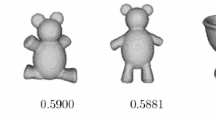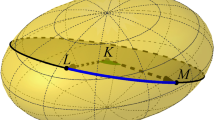Abstract
When a flat figure of uniform color and with an elliptic contour is slowly rotated around an axis orthogonal to the plane of the image, an observer set in the frontal position will perceive it first as a rotating ellipse. After a few seconds of inspection, the ellipse appears to deform with an amoeba-like movement until it appears as a rigid, circular disk tilting back and forth in 3-D space; finally it is seen as a rotating ellipsoid tilted in depth at a constant inclination angle with respect to the rotating platform. In an attempt to provide an explanation for the apparent ellipsoid, the authors present a mathematical model based on an hypothesis of velocity differences minimization, successfully used to describe other stereokinetic phenomena, such as “the rotating cone” and the ”tilted bar”. This technique does not make use of Ullman's “ridigity hypothesis” for extracting depth from 2-D moving stimuli. A comparison with experimental results supports the validity of the model.
Similar content being viewed by others
References
Beghi L, Xausa E, Zanforlin M (1991) Analytic determination of depth effect in stereokinetic phenomena without a rigidity assumption. Biol Cybern 65:425–432
Bennet B, Hoffman D (1985) The computation of structure from fixed axis motion: nonrigid structures. Biol Cybern 51:293–300
Braunstein ML (1976) Depth perception through motion. Academic Press, New York
Braunstein ML, Anderson GJ (1984) A counterexample to the rigidity assumption in visual perception of structure from motion. Perception 13:213–217
Braunstein ML, Hoffman DD, Pollick FE (1990) Discriminating rigid from nonrigid motion: minimum points and views. Percept Psychophys 47:205–214
Bressan P, Vallortigara G (1986) Multiple 3-D interpretations in a classic stereokinetic effect. Perception 15:405–408
Cowie RID (1987) Rubber rhomboids: nonrigid interpretation of a rigid structure moving. Percept Psychophys 42:407–408
Cutting JE (1987) Perception and information. Ann Rev Psychol 38:61–90
Gregory RL (1980) Perception as hypothesis. Philos Trans R Soc London B 290:181–197
Longuet-Higgins HC (1986) Visual motion ambiguity. Vision Res 26:181–183
Marmolin H (1973) Visually perceived motion in depth resulting from proximal changes; I and II. Percept Psychophis 14:133–142, 143–148
Musatti CL (1924) Sui fenomeni stereocinetici. Arch Ital Psicol 3:105–120
Musatti CL (1928) Sui movimenti apparenti dovuti ad illusione di identita' di figura. Arch Ital Psicol 6:205–219
Musatti CL (1955) La stereocinesi e il problema delia struttura dello spazio visibile. Riv di Psicol 49:3–57
Nakayama K (1985) Biological image processing: a review. Vision Res 25:625–660
Poggio T, Koch C (1985) Ill-posed problems in early vision: from computational theory to analogue networks. Proc R Soc London B 226:303–323
Renwall P (1929) Zur Theorie des stereokinethischen Phenomenes. Kaila E (ed) In: Annales Universitatis Aboensis, Ser B Tom X:13–75
Shulman D, Aloimonos JY (1988) (non-) rigid motion interpretation: a regularized approach. Proc R Soc London B 233:217–234
Ullman S (1979) The interpretation of visual motion, MIT Press, Cambridge, Mass
Ullman S (1984) Maximizing rigidity. The incremental recovery of 3-D structure from rigid and non-rigid motion. Perception 13:255–274
Vallortigara G, Bressan P, Zanforlin M (1986) The Saturn illusion: a new stereokinetic effect. Vision Res 26:811–813
Vallortigara T, Bressan P, Bertamini M (1988) Perceptual alternations in stereokinesis. Perception 17:31–34
Walker JT (1989) The vista paradox: a natural visual illusion. Percept Psychophys 45:43–48
Wallach H, O'Connel DN (1953) The kinetic depth effect. J Exp Psychol 45:205–217
Wallach H, Weiss A, Adams PA (1956) Circles and derived figures in rotation. Am J Psychol 69:48–59
Zanforlin M (1988a) The height of a stereokinetic cone: a quantitative determination of a 3-D effect from 2-D moving pattern without a “rigidity assumption”. Psychol Res 50:162–172
Zanforlin M (1988b) Stereokinetic phenomena as good Gestalts: the minimum principle applied to circles and ellipses in rotation: a quantitative analysis and a theoretical discussion. Gestalt Theor 10:187–214
Zanforlin M (1989) Le illusioni ottiche nello studio della percezione visiva: fenomeni irrilevanti o nodi cruciali del problema? Riv Psicol LXXIV 2:11–31
Zanforlin M, Vallotigara G (1988) Depth effect from a rotating line of constant length. Percept Psychophys 44:493–499
Zanforlin M, Vallortigara G (1990) The magic wand: a new stereokinetic anomalous surface. Perception 19:447–457
Author information
Authors and Affiliations
Rights and permissions
About this article
Cite this article
Beghi, L., Xausa, E., De Biasio, C. et al. Quantitative determination of the three-dimensional appearances of a rotating ellipse without a rigidity assumption. Biol. Cybern. 65, 433–440 (1991). https://doi.org/10.1007/BF00204656
Received:
Accepted:
Issue Date:
DOI: https://doi.org/10.1007/BF00204656




